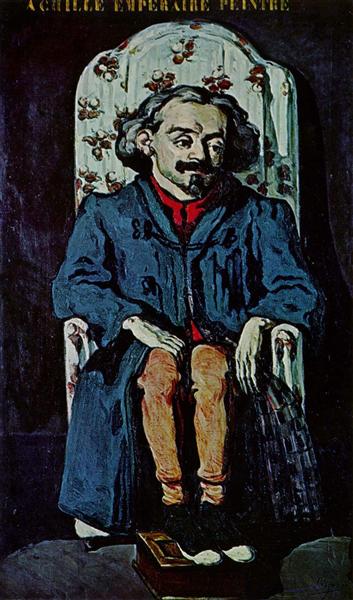Description
Paul Cézanne's "Aquiles Emperor" (1868) is a fascinating testimony of the artistic transition between realism and modernity that characterizes the work of the master postimpressionist. In this painting, Cézanne places the character of Achilles in a context that, although not directly evokes classical mythologies, establishes a powerful emotional and aesthetic connection with the figure it represents. The work is inscribed in the Cézanne period in which it experienced with the human figure, looking for ways to represent the substance and depth of human experience through geometrization and construction of color.
From the first glance, the use of a palette of terrible colors stands out, where ocher predominate, the green off and the touches of blue, which provide an atmosphere of melancholic serenity. The Achilles figure is presented in a robust and almost monumental way, dominating the pictorial space. Cézanne achieves here a balance between the physical vigor of the character and a certain vulnerability that manifests itself in his position, which refers to both heroic action and introspective reflection, a sign of the duality inherent in the human being.
The artistic composition of "Achilles Emperor" is equally captivating. Cézanne uses a dynamic disposition of forms, where the lines of the figure contrast with the fragmented background of the work. This background, which resembles a mixture between the landscape and abstract elements, suggests an environment that dissolves in the spectator's perception, emphasizing the central figure. Instead of a detailed environment, Cézanne opts for a background that complements the figure without disregarding, an choice that reinforces the importance of basic forms and color in his work.
Cézanne also moves away from the literal representation, opting for a stylization that invites interpretation. The way in which it has defined the contours and the texture of Achilles' The sensations it evokes. This reconfiguration of objectivism in painting becomes a preamble to the most abstract approach that many artists will adopt in the twentieth century.
In addition, the work presents an approach to symbolism and allegory. Achilles, as it appears, embodies the struggle and transcendence, recurring themes in Cézanne's work, which reflect their interest in capturing the essence of human emotions and their relationship with nature. The choice of a mythological hero also indicates the desire for elevation through art; The artist seeks not only to represent, but also transmit a message that resonates in the existential experience of the viewer.
In conclusion, "Aquiles Emperor" is a work that not only represents a particular moment in Cézanne's artistic development, but also serves as a mirror of his time. The synthesis between figure and background, the exploration of color and shape, as well as the symbolic burden of its content, make this painting a clear example of the path to the modernity that Cézanne was forging. Through this work, the viewer can experience a connection full of emotion and contemplation, characteristics that continue to resonate in contemporary art and have established Cézanne as one of the fundamental pillars of art history.
KUADROS ©, a famous paint on your wall.
Hand-made oil painting reproductions, with the quality of professional artists and the distinctive seal of KUADROS ©.
Reproduction service paintings With a guarantee of satisfaction. If you are not completely satisfied with the replica of your painting, we refund your money 100%.

